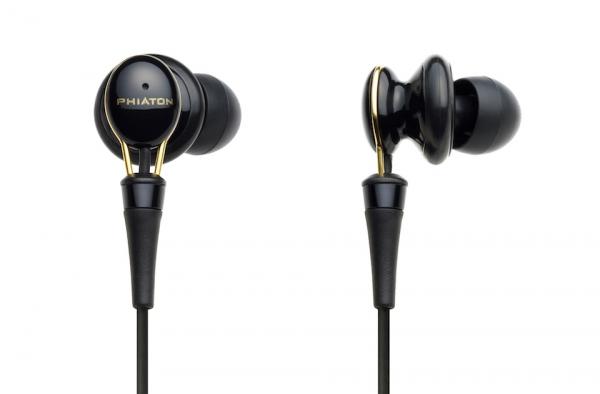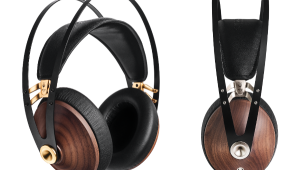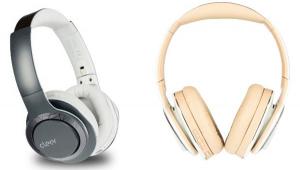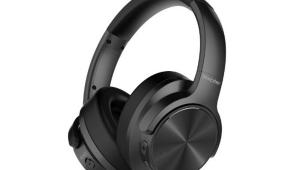Review: Phiaton PS 20 BT Bluetooth In-Ear Headphones

After trying several Bluetooth headphones, I’m surprised this category hasn’t taken off yet. With Bluetooth, you’re unencumbered by pesky cables. You can leave your cell phone in your pocket, on a table, etc., and control volume and track forward/reverse wherever you roam, as long as you don’t stray further than 30 feet. And unlike almost all mic-equipped headphones, Bluetooth headphones work as well with Androids as they do with iPhones.
While there are probably a dozen or so Bluetooth headphones available as I write this, I could find only three Bluetooth in-ear monitors (IEMs), all low-end models from “phone guys” like LG, Samsung, and Sony/Ericsson. The $149 Phiaton PS 20 BT may be the only Bluetooth IEM available from a headphone specialist. But I think that might change if more consumers get a chance to try out this form factor.
The PS 20 BT’s earpieces are tethered to a tiny Bluetooth 3.0 receiver/amplifier module with an 18-inch cable. The module has a spring clip you can use to attach it to your clothing, or you can hang it around your neck from an included lanyard. A microphone built into the module lets you take calls while using the PS 20 BT. A tiny joystick controls volume and pause/play, and skips tracks forward and reverse. A micro USB jack allows recharging of the internal battery.
Although I didn’t use the PS 20 BT at the gym — that would require, you know, actually going to the gym, and for that matter, actually belonging to a gym in the first place — the form factor seems ideal for the treadmill.
The mating process was typical for Bluetooth headphones. Put the phone and the PS 20 BT in mating mode and they find each other in a few seconds. After that, whenever I powered up the PS 20 BT, it connected immediately with my phone as long as the phone’s Bluetooth was activated.
The PS 20 BT includes a spring-snap velouresque case and rubber tips in four sizes.
Blues in Bluetooth
The PS 20 BT employs an unusual “half in-ear” design. The rather large, flat driver assembly sits outside your ear canal, while the angled earpieces fit deep inside.
I found that the half in-ear design had a major impact on the sound. The driver assembly helps provide a good seal, in conjunction with the supplied rubber tips. In fact, it can make for too good a seal. The better the seal, the more bass you get. When I first tried the PS 20 BT, I found that any material with deep bass content, such as typical rock music, sounded bloated and dull. Frequent S+V listening panelist Lauren Dragan, when trying the similar PS 20 NC (a version of the PS 20 BT with noise cancelling but without Bluetooth), complained that it sounded like “a speaker covered with a piece of foam.”
I soon realized, though, that the half in-ear design allows more precise adjustment of fit than most IEMs permit. As a result, it facilitates easy fine-tuning. By pulling the earpieces out a bit then gently pushing them in until the bass sounded just right, I was able to adjust the balance to my taste. The excellent fit kept the earpieces in place—and thus preserved my fine-tuning — even while I was walking around.
With most IEMs, if they’re not inserted firmly into your ears, you get little or no bass. If you pull them out just a bit, you can throw the tonal balance way off. The extra isolation provided by the large driver enclosures in the PS 20 BT’s earpieces assures that you’ll get plenty of bass, and makes this fine-tuning capability possible.
With the sound thus optimized, the PS 20 BT delivered outstanding performance for an IEM with dynamic drivers. The balance of bass, midrange, and treble was ideal. I couldn’t find a single singer that sounded bloated or harsh or thin or in any way unnatural through the PS 20 BT. Even Rev. Dennis Kamakahi’s rendition of “Kaua’i O Mano” from his Pua’ena CD sounded great; Kamakahi’s resonant baritone tends to sound a little bloated through most speakers and headphones, but not through these. Meanwhile, his slack-key guitar sounded rich, detailed, and ambient, from the deep bass notes on the detuned sixth and fifth strings to the crisp, arpeggiated tones of the B and E strings.
I tried every kind of blues, pop, rock, and jazz on my phone through the PS 20 BT, and its tonal balance suited all of them, from blues guitarist Jimmy Vaughan to R.E.M. to The Cult to The English Beat to early Sonny Rollins to the World Saxophone Quartet.
The bass is a hair on the fat side, adding a little extra weight while detracting just a bit from punch and pitch definition. It’s more like the heavy sound of Led Zeppelin bassist John Paul Jones than the more tuneful sound of, say, Paul McCartney. But it’s a more subtle distinction than that rather extreme analogy suggests.
The treble detail was excellent for dynamic drivers. It didn’t have the delicacy of the best balanced-armature drivers. But because the balance was so just-right, even all-treble recordings like Twin House, an album of fleet-fingered acoustic guitar duets by Larry Coryell and Philip Catherine, sounded natural through the PS 20 BT. I also noticed a great sense of ambience; the congas in “Clinton Hill,” from jazz guitarist Spencer Katzman’s mellow-grooving 5 Is the New 3 CD seemed to be coming from about 12 feet behind my head.
Note, though, that as with all IEMs, the fit dictates the sound. I think the half in-ear design will work well for most people, but S+V web editor Michael Berk hasn’t had much luck with them.
Measurements
I measured the PS 20 BT using a G.R.A.S. Type 43AG ear/cheek simulator, a Clio FW audio analyzer, and a Sony HWS-BTA2W Bluetooth transmitter to get signals from the Clio to the headphones. The medium-sized tips (second-largest of the four sizes supplied) fit the 43AG’s fake rubber ears the best, although there was a great deal of variability in the bass response due to minor changes in earpiece positioning.
The frequency response measurements indicate an essentially flat tonal balance, with peaks at 2.2 and 5.3 kHz that are fairly typical for a neutral-sounding headphone. The bass response may seem to be stronger in the left channel, but this is a result of positioning of the earpiece in the ear/cheek simulator. I was unable to position the right channel earpiece in a way that would duplicate the left channel’s strong bass response, but I’m confident this was due to positioning differences and not to the design or manufacturing of the PS 20 BT. As described in the review, the bass response you hear will be the result of your own fine-tuning of the position of the earpieces in your ears.
As will the isolation. With the tips I chose and the earpiece position I used for the measurement, isolation was typical for an IEM up to 5 kHz, but somewhat below average at higher frequencies.
Because of the latency of the Bluetooth transmitter and receiver (around 100 ms), I couldn’t do my usual distortion sweeps; the Clio’s log chirp and MLS measurement modes could handle the latency, but the sine sweep mode used for distortion measurements couldn’t accommodate the delay. However, I was able to take distortion measurements at specific frequencies. At 80 dB (measured with pink noise, A-weighted), total harmonic distortion (THD) was 0.08% at 1 kHz, 0.08% at 100 Hz and 5.1% at 20 Hz. At 100 dB, THD was 0.12% at 1 kHz, 0.10% at 100 Hz, and 45% at 20 Hz. These numbers are very low except in the deep bass, where they’re comparatively high.
Sensitivity measurements are irrelevant with an internally amplified product like this, but I can say that the PS 20 BT played very loud when fed Bluetooth signals from my Motorola Droid Pro phone — in fact, it had no problem playing at higher volumes than I could stand. Impedance measurements were also irrelevant (and impossible without cutting the cables) because of the internal amplification. And of course, I couldn’t do my usual 5 ohms vs. 75 ohms response comparison.
Cut the Cable With Confidence
If you’re willing to fuss a little with the positioning of the PS 20 BT’s earpieces, you can enjoy outstanding sound with all the cable-free convenience of Bluetooth. Even though I don’t especially need Bluetooth IEMs because I bike for exercise and it’s illegal to wear headphones in both ears while you’re biking on the street, I still thoroughly enjoyed using the PS 20 BT while I was just walking around the house, working on my bikes, cooking, or whatever. The PS 20 BT is one of the most convenient, user-friendly headphone options available today, and just as important, it sounds great.
- Log in or register to post comments




































































